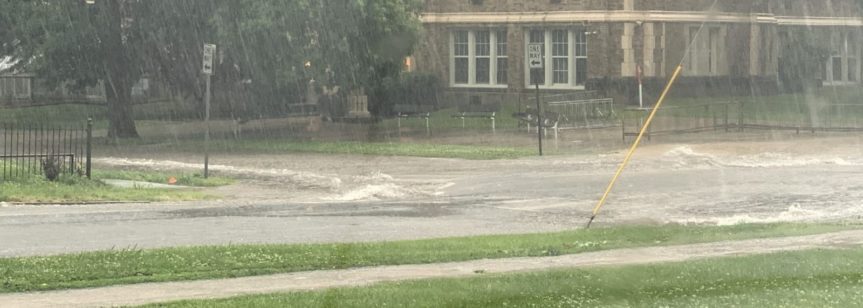“I’ve never seen so much rain.”
We’ve heard that a lot over the past couple of weeks. From thunderstorms lasting hours on end to torrential downpours dumping 4”+ at a time, many communities have seen a 2” – 8” increase in precipitation over the past month. The magnitude of these events (50-year to 100-year) has exceeded the storm events (10-year to 25-year) set as design standards for the sizing of drainage facilities.
All of that water is going somewhere…but what happens if that somewhere is your building? The rainfall magnitudes experienced on Father’s Day and again last week have led to a variety of unforeseen damages.
When it comes to water damage, time is of the essence. Inspecting a building before it has a chance to dry out is key to designing a solution. At Klingner, we work alongside disaster / damage mitigation companies to pinpoint problem areas using a combination of IR cameras and moisture meters. This information gathered can assist with potential documentation for insurance claims – a process which we frequently assist with via coordination and documentation. Once documented, mediation companies then remove the water, moisture, and potentially water damaged material to prevent further damage.
However, water removal is really just the first step.
Improving your environment is just as important as cleanup. Bringing an architect into the process of restoring or rethinking your space has more than aesthetic benefits – it also results in a more comprehensive repair. Our architects possess a wealth of knowledge about building materials, finishes, and how both will react in similar conditions. As they assess the damage inside and out, our architectural team actively identifies materials that should be removed or replaced, as well as areas that might be susceptible in the future. Design standards are always being improved to prevent water intrusion. Whether it’s correcting insufficient flashing details, addressing roof failures, or identifying solutions for any number of other building issues, an architect can present the most appropriate options to minimize future damage for each unique situation.
Severe storms may also reveal a longer history of water infiltration and environmental issues, such as mold, that require specialized engineering expertise. Some disaster / damage mitigation experts require mold remediation protocols before their cleanup work begins. Klingner engineers start by taking air samples to establish a baseline, then create clear instructions for what materials to clean and what materials to replace. And if the water or mold-affected materials potentially contain asbestos, which is common in older structures, our inspectors can collect samples, analyze them, and provide management plans to ensure work is done safely. After the work is complete, we take one more round of air sampling from the space to make sure remediation was a success.
The final piece of the flood repair puzzle is drainage. Taking steps to address drainage challenges now can reinforce a building’s protection in the future. Cleaning out gutters; keeping trash and debris away from storm drains; and maintaining, testing, or replacing your sump pump are all good starting places for any building owner. But if you think you have a larger problem, seeking out an engineer’s expertise is crucial. Common and more significant localized drainage and flooding issues include undersized drainage components (i.e. culverts, drain tiles, gutters, sump pumps), surface grading issues (i.e. ponding water adjacent to foundation), poor vegetation / erosion protection, and / or foundation failures (i.e. cracks). The projects required to correct these issues can vary drastically in magnitude and many times require the consultation of a professional. Working with licensed water resources, site, and structural engineers helps you better assess these larger problems and choose a solution that can handle future rainfall events.
A comprehensive approach to flood and water damage doesn’t end with inspection and cleanup. Making a full recovery involves reinforcing your building, addressing environmental hazards, and improving drainage. Involving architects and engineers is the surest way to make sure you’re hitting every step of this process – and finding appropriate solutions to protect your building now and in the future.
